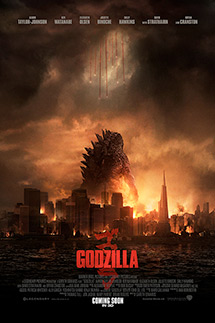 The last time Hollywood tried to tackle Japan’s King of Monsters, we got Roland Emmerich’s 1998 Godzilla, which seemed to fundamentally misunderstand the franchise. It seemed to have taken only the most cursory look at the rubber suits and decided that there was nothing about the series that was worth revering. The result was a film so bad that Godzilla’s parent company ended up disowning it, and had that movie’s version of the monster quickly destroyed in 2004’s Final Wars. Gareth Edwards’ Godzilla takes a completely different approach. He applies Spielbergian technique to the monster, concentrating on delivering sheer awe from moment to moment.
The last time Hollywood tried to tackle Japan’s King of Monsters, we got Roland Emmerich’s 1998 Godzilla, which seemed to fundamentally misunderstand the franchise. It seemed to have taken only the most cursory look at the rubber suits and decided that there was nothing about the series that was worth revering. The result was a film so bad that Godzilla’s parent company ended up disowning it, and had that movie’s version of the monster quickly destroyed in 2004’s Final Wars. Gareth Edwards’ Godzilla takes a completely different approach. He applies Spielbergian technique to the monster, concentrating on delivering sheer awe from moment to moment.
The film opens in 1999. A mining operation in the Philippines unearths a massive prehistoric fossil, and accidentally unleashes an ancient parasite into the world. What was unleashed ends up destroying a nuclear power plant on the coast of Japan. The event is covered up, and fifteen years later, the danger reawakens in a new form. The military is quickly deployed to try and stop the threat as it heads into major population centers. But the arrival of this monster has awakened others, and their paths are quickly converging.
There are further details to this plot that involve the specific plans of the military and an explosive ordnance disposal specialist played by Aaron Taylor-Johnson trying to get back to his family. And that’s all fairly well done, but it’s obviously a secondary concern for the film. When you get right down to it, the film is just a series of meticulously constructed sequences that play out the sheer awe and terror that would come with the arrival of these massive creatures. Much of the film plays out on a very human scale, with the camera always eye level with poor, tiny people caught in the wake of the creatures’ destruction.
Director Edwards clearly takes his cue from Steven Spielberg. If Jaws and Jurassic Park taught us anything, it is that the power of a monster is the fear it instills when it isn’t even on screen. The film is patient, showing only bits and pieces of its destructive capacity for a good long time. It focuses on the buildup and the aftermath. It lingers on tremors and distant explosions and thrives on big, spooky reveals. And then it cuts away, holding off on the payoff as it returns to the human scale. A lot of blockbusters nowadays are all about instant gratification, most of them working off a formula that requires an action sequence every few minutes. This often results in a film with an underwhelming climax. In contrast, Godzilla takes its time, and delivers a massive, thoroughly satisfying payoff. It delivers all this with consummate technical skill and gorgeous visuals.
Standing at the center of this destruction is Aaron Taylor-Johnson, who doesn’t really have much of a commanding presence. The film goes for long stretches without dialogue, and it would have probably been better served by a more expressive actor. He’s certainly outshined by the film’s ridiculously overqualified supporting cast. Many of the film’s characters seem entirely functional, with no real personality beyond their job descriptions. And yet, they manage to be compelling because they’re played by actors like Ken Watanabe, David Strathairn and Elizabeth Olsen. The one meaty part in this film is handled expertly by Bryan Cranston, who imparts the film with enough pathos to carry it through its entire runtime.
Godzilla teases a measure of social and political relevance, but it ultimately doesn’t follow through on it. It’s a little disappointing, given what was already laid out. But what we get it still pretty great. It’s certainly everything we need from a new Godzilla movie. It is a carefully considered spectacle; the kind that we haven’t really seen in this current age of frantic, overstuffed blockbusters. It isn’t a film that’s about stuffing as much action as it can into its runtime. It wants to make jaws drop. It wants to offer something beyond the instant gratification of things hitting each other. It puts the audience in there with these other tiny people, staring up at impossibly massive creatures. It is designed to awe.
My Rating:











